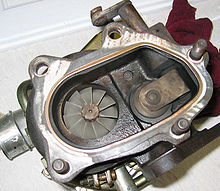A wastegate is a valve that diverts exhaust gases away from the turbine wheel in a turbocharged engine system. Diversion of exhaust gases regulates the turbine speed, which in turn regulates the rotating speed of the compressor. The primary function of the wastegate is to regulate the maximum boost pressure in turbocharger systems, to protect the engine and the turbocharger. One advantage of installing a remote mount wastegate to a free-float (or non-WG) turbo includes allowance for a smaller A/R turbine housing, resulting in less lag time before the turbo begins to spool and create boost.
How a Turbo Wastegate Works.
- A wastegate is an integral part of a turbocharger that ensures the motor doesn't get too much boost pressure as the turbo spools and rpms build. The wastegate is exactly what the name implies--a gate (or flap) that opens to divert waste (excess pressure from the turbo) into the exhaust or the atmosphere rather than into the turbo. In this way, the wastegate serves to regulate and protect the engine and turbocharger from excess boost. When boost pressure reaches a certain point--say, 10 psi or less for a normal-production turbocharged car--the flap of the wastegate opens and diverts pressure away from the turbine wheel.
- There are two types of wastegate, most common of which is the internal wastegate. This is usually found on cars with low boost settings like 5 psi or 6 psi, or even up to 10 psi. An internal wastegate is found inside the turbo housing and is a crucial component of the turbo itself. The diaphragm is connected to a hose that goes to the turbocharger compressor outlet, charge pipes or intake manifold. The gate is opened when the diaphragm on the wastegate is actuated. When boost pressure exceeds a predetermined amount, the diaphragm opens the spring-loaded wastegate bypass flap, allowing some of the pressure to go around the turbo's impeller, slowing it down. The excess pressure is then evacuated to the exhaust.
- The other type of wastegate is an external wastegate. As its name implies, the external type is separate from the turbo housing. It doesn't requires an actuator to function. This type of wastegate is actuated by a valve similar to a valve used in a cylinder head. Excess exhaust is either diverted from the turbo to the exhaust or evacuated into the atmosphere. The latter is referred to as a divorced wastegate, and is much louder than one that diverts to the exhaust. Most aftermarket turbo kits utilize an external wastegate; this type works well for setups that are generating 20 psi to 30 psi. An external wastegate must be installed with a special manifold that has an extra runner that works only with the wastegate. Because there are no space restraints, external wastegates can be much larger and can regulate boost levels more precisely.
Internal Wastegate

External Wastegate




0 comments:
Catat Ulasan